
Cotinus, Smoke Bush: Planting, Pruning, Care
Contents
The Smoke Tree in a Nutshell
- The smoke tree or wig tree boasts a stunning, feathery bloom
- Easy to grow and tolerant of limestone, it adapts to almost any soil
- Its foliage displays magnificent autumn colours
- Vigorous and hardy down to -20°C
- Brightens up hedges, flower beds and even terraces
Our expert's advice
The Cotinus, particularly the Cotinus coggygria and its American cousin, Cotinus obovatus, nicknamed “smoke bushes”, are large, bushy deciduous shrubs with green or purple foliage that turns into sumptuous hues in autumn. Their inflorescences create a spectacular feathery effect in summer, resembling the shape of a wig.
With deep purple foliage like the famous Cotinus ‘Royal Purple’, intense red in the cultivar ‘Grace’, or golden yellow in Cotinus ‘Golden Spirit’, they enchant throughout summer and autumn. As the seasons change, their leaves transform beautifully from yellow to orange, then to garnet red or deep purple as winter approaches.
Native to the Mediterranean, the smoke bush is cold-hardy and exceptionally heat-tolerant. Easy to grow, it thrives in full sun or partial shade and adapts to all soil types (as long as they are well-drained), including chalky and stony soils.
A moderately growing shrub, Cotinus is a substantial plant, perfect for adding seasonal colour to the garden and brightening up informal hedges, mixed shrub borders with evergreens, and sunny rockeries. Some dwarf varieties are now well-suited to small spaces and even container growing.
Explore our collection of this hardy, resilient shrub that brings fiery, surprising brilliance to all natural gardens.
Description and botany
Botanical data
- Latin name Cotinus, Cotinus Coggygria
- Family Anacardiaceae
- Common name Smoke tree, Venetian sumach, Wig tree
- Flowering May to September
- Height 1 to 10 m
- Exposure Sun, partial shade
- Soil type All types, well-drained
- Hardiness -20°C
The Cotinus, commonly known as the “wig tree” or “Venetian sumach” and “Jupiter’s beard”, belongs to the large Anacardiaceae family. The genus consists of just two species of deciduous trees and shrubs: the Eurasian Cotinus coggygria (the most well-known) and its North American cousin Cotinus obovatus. They grow naturally in rocky areas and dry climates. There are about a dozen cultivars, plus a few hybrids.
In our country, this usually bushy shrub grows easily in gardens throughout France. It occurs naturally on dry, poor, calcareous or even arid hillsides in the southeast, from Alpes-Maritimes to Ain, Ardèche, Gard and Aveyron. It withstands drought, wind and urban pollution well.
Cotinus coggygria forms a bushy shrub with a dense, irregular habit, with gnarled, spreading branches, reaching an average height of 3 to 6 m with a similar spread. Cotinus obovatus is the larger species, growing up to 10 m tall with an 8 m spread. It has a dense, globular and wider habit. If left unpruned, Cotinus can develop a distinctive dome shape that becomes quite imposing. The branched trunk has smooth bark that becomes rough and fissured with age.
There are also dwarf varieties such as Cotinus coggygria ‘Lilla’ and Cotinus ‘Young Lady®’ with a very compact habit, reaching a maximum height of 1.2 to 1.5 m and a spread of 1 m at maturity.
With Cotinus, the foliage provides a spectacular show all year round. This slightly unruly vegetation stands out for its exceptional autumn colour. The deciduous leaves appear from April; they are rounded oval in shape and measure 5 to 15 cm long depending on the variety. They are arranged alternately on the branches and in rosettes at the branch tips.
Some varieties have deep purple foliage, like coggygria ‘Royal Purple’, while others have apple-green or golden yellow leaves, like Cotinus coggygria ‘Golden Spirit’. Their hues change with the seasons, some lightening in summer. All take on warm autumn tones from October onwards, ranging from orange-red with coppery reflections to lemon yellow, vermilion orange, scarlet red, reddish purple and violet.
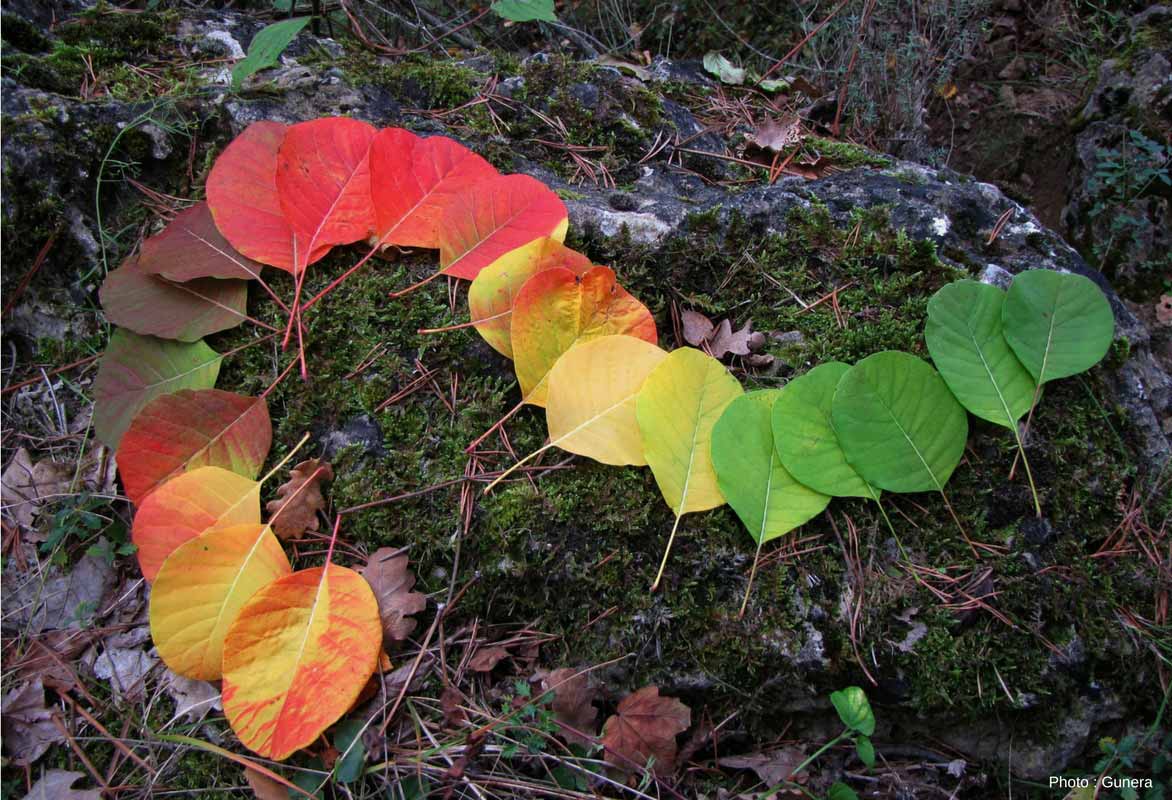
The wide range of autumn colours Cotinus can display
When crushed, the young shoots and leaves release a characteristic turpentine-like scent.
As spectacular as it is surprising, the flowering consists of a multitude of feathery peduncles, enveloping the Cotinus foliage in graceful plumes from summer to autumn. In May-June, numerous small greenish or yellowish flowers appear in airy terminal panicles. The pedicels of the sterile flowers then elongate into long filaments, forming a wispy, feathery mane in white, tea rose or purplish pink, more rarely coppery orange (‘Golden Spirit’), resembling an old man’s beard or, more aptly, a wig, which gives the Cotinus its nickname “wig tree”. Across the Channel, it’s called the “smoke tree”, as these cottony inflorescences evoke clouds of smoke rather than feathers to the English.
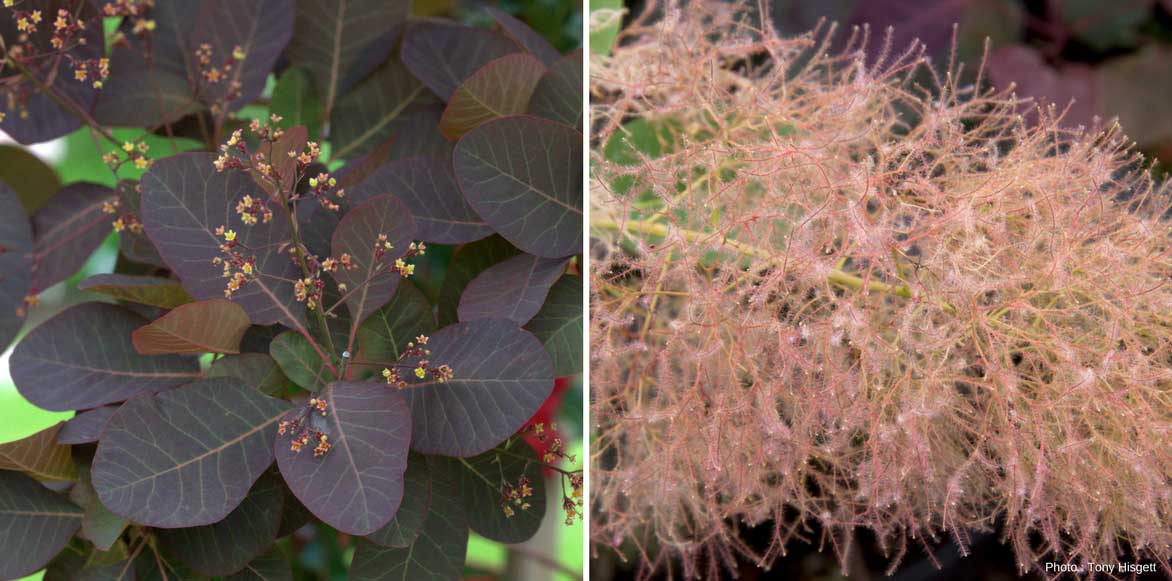
The flowering of Cotinus or Wig tree
Honey-producing, these plumes attract bees. The feathery branches of Cotinus make lovely fresh summer bouquets or dried winter arrangements. In September, small brown, shiny and wrinkled fruits appear scattered on the feathery infructescence.
Easy to grow and very hardy (down to -20°C), and like its cousin the Virginian sumac, tolerating heat well, Cotinus thrives in well-drained, poor and light soils. It adapts to all soil types, even chalky and stony ones. Once established, it withstands drought but dislikes excessive winter moisture, especially in heavy clay soils. While it tolerates partial shade, it prefers full sun, where its reddish-purple leaves glow intensely in the slightest ray.
With its dense, slightly unruly habit, Cotinus is a must for informal and naturalistic gardens. It fits perfectly into mixed hedges, rockeries or shrub borders, or even in a large pot on a terrace. Its modest size makes it ideal for small gardens.
The sap of the wig tree that oozes from its branches is highly irritating to the skin. Its wood was once used by luthiers and cabinetmakers.
Species and main varieties
The smoke bush typically doesn’t exceed six metres in height, except for the c. obovatus species which can reach 10 m. In recent years, more compact dwarf varieties have emerged like ‘Young Lady’, perfect for small spaces and container growing.
The most common species in our gardens is Cotinus coggygria, which comes in about a dozen cultivars including the famous Cotinus ‘Royal Purple’. Some feature purple foliage, others green or golden yellow leaves. The branches of purple-leaved varieties are slightly less feathery but their foliage is particularly ornamental.
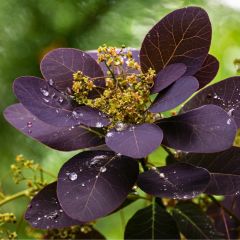
Cotinus coggygria Royal Purple - Smoke Bush
- Flowering time July to September
- Height at maturity 3,50 m
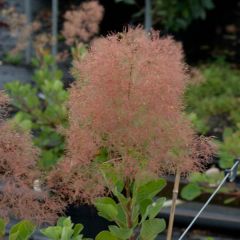
Cotinus coggygria - Smoke Bush
- Flowering time June to September
- Height at maturity 3 m
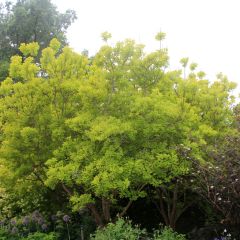
Cotinus coggygria Golden Spirit - Smoke Bush
- Flowering time June to September
- Height at maturity 3 m
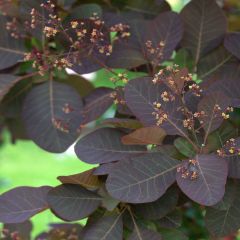
Cotinus Grace - Smoke Bush
- Flowering time August, September
- Height at maturity 5 m
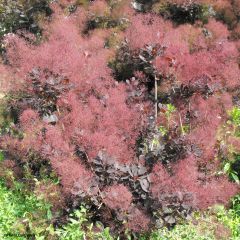
Cotinus coggygria Lilla - Smoke Bush
- Flowering time July to September
- Height at maturity 1 m
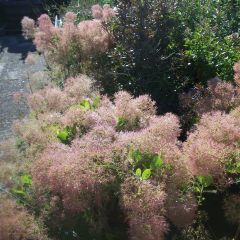
Cotinus coggygria Young Lady - Smoke Bush
- Flowering time July to September
- Height at maturity 1,20 m
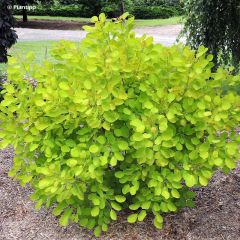
Cotinus coggygria Golden Lady - Smoke Bush
- Flowering time July to September
- Height at maturity 2 m
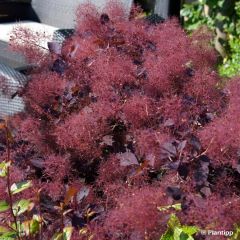
Cotinus coggygria Dusky Maiden - Smoke Bush
- Flowering time July to September
- Height at maturity 2,50 m
Discover other Cotinus - Smokebush
Planting
Where to Plant the Smoke Bush
While the smoke bush thrives in the dry climates of our arid hills in the South-East, it can be grown anywhere in France. It is capable of withstanding very low temperatures of -20°C, ensuring excellent hardiness in all regions.
This is a low-maintenance shrub, easy to grow in well-draining, poor, and light soil, even very chalky. It dislikes heavy soils, compact and clayey, especially those waterlogged in winter. Once established, it tolerates drought well, along with heat, wind, and urban air pollution.
In terms of exposure, it prefers full sun, which enhances its purple or golden foliage, though it can tolerate light partial shade where it will be less vibrant.
Versatile, this shrub works well as a standalone for a spectacular summer and autumn display or in a mixed hedge with other decorative shrubs like forsythia, mock orange, or cotoneaster, or in a bed of evergreen shrubs. It is ideal for covering a difficult, barren slope where other shrubs wouldn’t thrive, alongside tall grasses or buddleias.
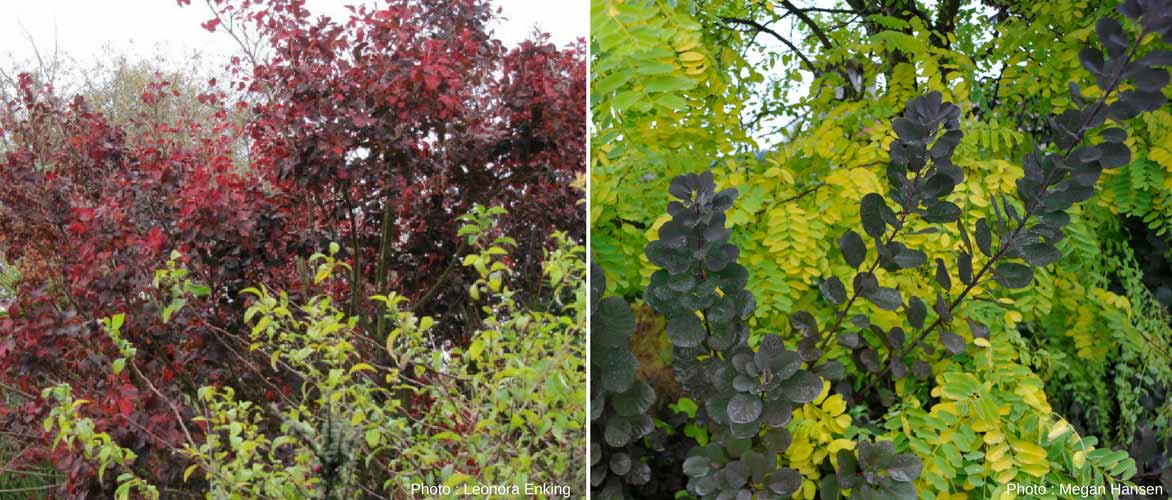
The smoke bush (here, ‘Royal Purple’) is perfect for mixed hedges
Smaller varieties are well-suited for dry rock gardens with nepeta, stachys, lavender, and rosemary, and can be grown in pots on terraces or balconies.
When to Plant the Smoke Bush
Plant Cotinus preferably in spring between February and March or in autumn from September to November.
How to Plant the Smoke Bush
The smoke bush prefers well-draining soil where water does not stagnate. In a hedge, space plants 1 m apart.
In the ground
- Loosen the soil well and dig a hole 3 to 5 times wider than the root ball
- Add a generous layer of pumice or gravel at the bottom of the hole
- Plant the shrub without burying the crown
- Fill the hole while keeping the shrub upright and firm the soil with your foot
- Water thoroughly after planting and regularly during the first summers
In pots
Some dwarf varieties of smoke bush, such as Cotinus coggygria ‘Lilla’, are well-suited for container growing. The substrate must be very well-draining to avoid waterlogging.
- Place a thick layer of drainage (pot shards, gravel, or clay pebbles) at the bottom of a container at least 50 cm in diameter
- Plant in a good, slightly sandy potting mix
Maintenance, Pruning and Care
Cotinus requires no particular maintenance, being a shrub that’s resistant to both cold and intense heat. Pruning isn’t essential, but is recommended to maintain a harmonious, bushy shape and abundant foliage. As it ages, it tends to become sparse.
In February-March, before new growth appears, carry out fairly hard pruning by removing diseased or dead wood, the tips of branches damaged by frost and tangled branches to keep only the vigorous stems. Cut stems back by half to maintain a compact shape and denser branching. The aim is to slightly reduce the framework and create more transparency in your shrub.
The smoke bush responds well to hard pruning: after a few years, don’t hesitate to cut it back to ground level: in late winter, prune stems back to 2 or 3 buds from the base.
Possible diseases and pests
The smoke bush is rarely affected by diseases or pest attacks. The Cotinus’s only real enemy is excessive moisture. In spring, it may fall victim to verticillium wilt, a fungal disease caused by waterlogged conditions, which can lead to its decline: leaves turn yellow and become necrotic. There is no cure, so spray a horsetail or garlic decoction as a preventive measure from spring onwards. If infected, remove affected parts promptly.
Propagation
The smoke bush can be propagated by sowing, layering in March, and cuttings in June. We advise against sowing, as it’s too lengthy and difficult to succeed.
By softwood cuttings
- In May-June, take healthy shoot tips of 10-15 cm just below a node, ensuring at least 3 nodes remain
- Remove the lower leaves, keeping only two pairs of upper leaves
- Plant them in a well-draining, light mix of sand and compost
- Cover (with cling film for example) and place in a warm, humid environment
- Keep the substrate moist until rooting occurs, which takes 1 to 3 months
- Transplant your cuttings into open ground in autumn and water well during the first year
By layering
- In March, dig a 5-10 cm trench in the soil near the parent plant. Choose a flexible stem at the base of the shrub that can be easily bent to the ground
- Remove leaves from this section of the stem
- Bend it down towards the soil, burying a portion to encourage rooting
- Fill in the trench and secure the layer (you can use tent pegs or metal hooks)
- Lift the tip and stake the aerial portion
- You can separate the layer from the parent plant in autumn when it has sufficient roots, then replant it in open ground in your chosen location
Pairing
The Cotinus is an ornamental shrub for both summer and autumn, perfect for standalone planting or mixed borders. As a specimen plant, it creates a striking focal point in the garden, under which you can plant a carpet of heucheras and Hakonechloa, as shown in this setting:
It makes a beautiful backdrop for flower beds, standing out against dark evergreen foliage such as boxwood, escallonias, thujas, or viburnums.
In a mixed hedge, it pairs perfectly with other decorative shrubs like forsythia, mock orange, and cotoneasters. Purple-leaved varieties create striking contrasts alongside plants or shrubs with grey foliage (artemisias, Buddleia ‘Silver Anniversary’), blue tones (Eucalyptus gunnii), yellow hues (Sambucus nigra ‘Golden Tower’), or even the variegated foliage of the shrimp plant willow.
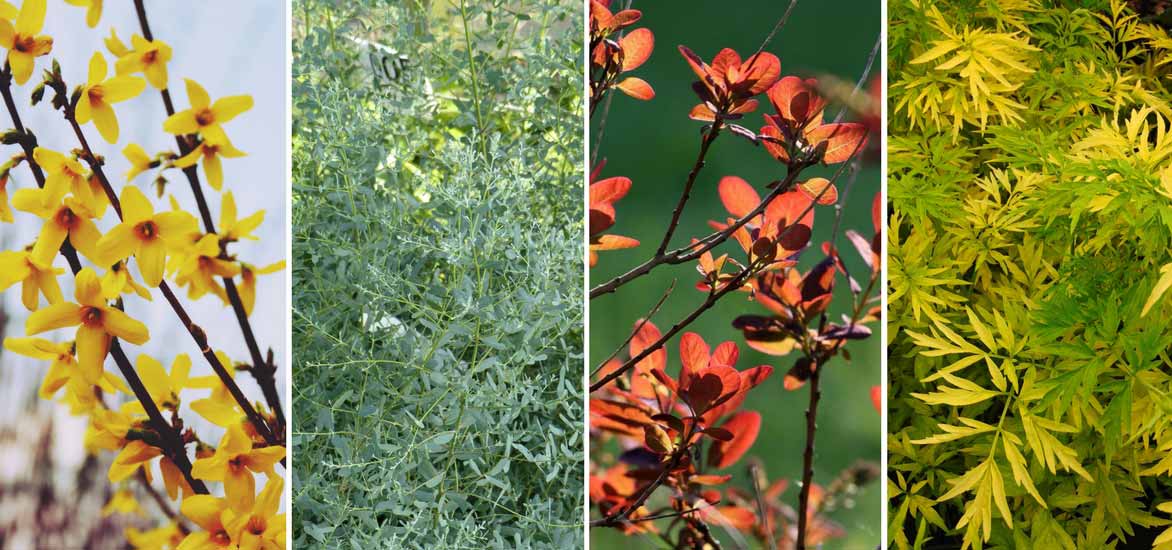
Forsythia, Eucalyptus gunnii ‘France Bleu’, Cotinus ‘Royal Purple’, and Sambucus nigra ‘Golden Tower’
It makes a stunning choice for dressing a large slope alongside tall ornamental grasses (Panicum virgatum, Stipa gigantea…).
In a dry rock garden, it thrives alongside nepetas, stachys, dianthus, lavenders, monardas, thymes, rosemary, or dwarf buddleias.
Cotinus can serve as a support for perennials like vigorous Geranium oxonianum ‘Claridge Druce’ or annual climbers such as morning glories or perennial peas. It can also host a clematis or a Lonicera, weaving through its branches to create a captivating tapestry of foliage and flowers.
Compact varieties like ‘Lilla’ or ‘Young Lady’ can be grown in pots on a sunny terrace or balcony, surrounded by blue flowers (Agastache ‘Blue Fortune’, Ceratostigma griffithii) or pink blooms (Salvia microphylla grahamii, hollyhocks, sedums…).

On New York’s High Line, Cotinus ‘Grace’, paired with grey birch (Betula populifolia ‘Whitespire’), is a true star!
Useful resources
- Discover our wide range of Cotinus or Smoke Bush
- Francis Peeters talks about Cotinus ‘Grace’ and Cotinus ‘Young Lady’ on the RTBF programme “Gardens and Leisure”
- Explore our advice sheet Purple Cotinus: The Most Beautiful Varieties
- Subscribe!
- Contents






































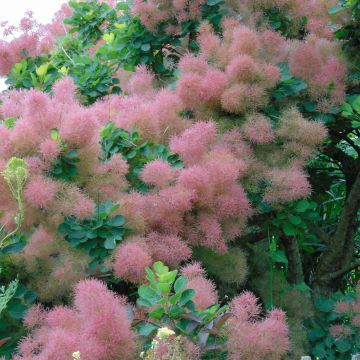
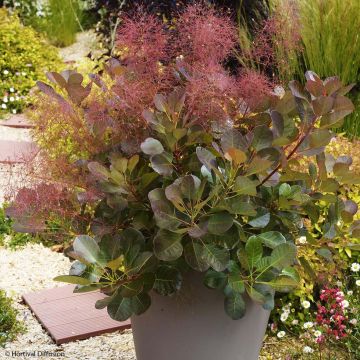



Comments